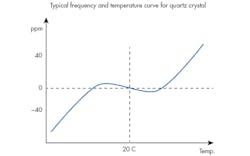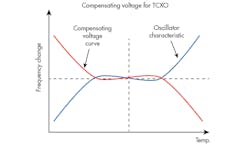It’s about to get hot in this post: Today we’re discussing temperature-controlled crystal oscillators.
So far in our oscillator series, we’ve touched on the most important aspects of oven-controlled crystal oscillators (OCXOs) and temperature-compensated crystal oscillators (TCXOs). In the previous TCXO post, we covered the four common types of TCXOs and performance. Now, let’s continue to dive deeper into TCXOs. This time we’ll discuss five key elements of a TCXO and the impacts of temperature.
By applying temperature compensation within the crystal oscillator module of a TCXO, it is possible to considerably improve the basic performance of the oscillator.
In view of their usefulness, a wide range is available from many suppliers in a whole variety of packages from a host of different surface-mount varieties to through-hole mounted ones, some of which are compatible with the dual in-line format used for many through-hole mounted integrated circuits.
How to Minimize the Effects of Temperature
Although crystal oscillators offer a highly stable form of oscillator, they are nevertheless affected by temperature. The cut of the actual crystal element from the overall grown crystal can help to minimize the effects of temperature, but they are still affected to some degree. For a crystal cut known as the AT cut, the drift with temperature can be minimized around normal ambient temperature, but the rate of drift will rise above and below this (Fig. 1).
The effects of temperature are, to a large degree, repeatable and definable. Therefore, it is possible to compensate for many of the effects using a temperature-compensated crystal oscillator (TCXO).
The TCXO Solution
A TCXO adjusts the frequency of the oscillator to compensate for the changes that will occur as a result of temperature changes. To achieve this, the main element within a TCXO is a voltage-controlled crystal oscillator (VCXO). This is connected to a circuit that senses the temperature and applies a small correction voltage to the oscillator (Fig. 2).
5 Main Elements of the Temperature-Controlled Oscillator
There are five different elements that comprise the overall temperature-controlled oscillator:
1. Compensation network. The compensation network is the key to the operation of the whole system. An approximate curve for the temperature frequency response of the oscillator is seen above. The actual curve can be expressed approximately in the form of a 3rd-order polynomial expression, although a more accurate representation takes into account some nonlinearities and works out to be close to a 5th-order polynomial. The compensation network needs to sense the temperature and produce a voltage that is the inverse of this (Fig. 3).
Early designs would have used analog circuitry and often directly used a network of capacitors, resistors, and thermistors to directly control the frequency of oscillation. This type of circuit included both blocks on the diagram of the compensation network and the crystal frequency pulling block.
Current technologies typically adopt an indirect approach where the temperature is sensed in the compensation network, and a voltage is generated that provides a frequency change that is the inverse of the temperature curve. This can be achieved using analog components, but current technologies often incorporate some form of digital signal processing (DSP) to be able to generate a far more accurate response, with the possibility of linearizing units separately by programming a ROM with the response of the particular oscillator. The DSP circuitry is often contained within a special ASIC so that it can be tailored to suit the application without draining too much current.
2. Oscillator pulling circuit. Once the voltage has been generated, this is applied to a circuit that can pull the frequency of the crystal oscillator. Typically, this incorporates a varactor diode and some lowpass filtering.
3. Crystal oscillator. The crystal oscillator circuit is normally a standard circuit, but one that is designed to give the operating conditions for the crystal with ideal drive levels, etc.
4. Voltage regulator. In order to prevent external voltage changes from introducing unwanted frequency shifts, the overall TCXO should incorporate a voltage regulator which itself should not introduce unwanted temperature effects.
5. Buffer amplifier. A buffer amplifier is required to give the increased drive to the output. It should provide isolation to the crystal oscillator from any external load changes that may be seen.
TCXOs normally have an external adjustment to enable the frequency to be reset periodically. This enables the effects of the aging of the crystal to be removed. The period between calibration adjustments will depend upon the accuracy required, but may typically be six months or a year. Shorter periods may be used if very high levels of accuracy are required.
How does it feel to be that much closer to becoming a TCXO master? You’re doing well young grasshopper!
Be sure to come on back for our next post in the series. We’ll be jumping over to VCXOs.




